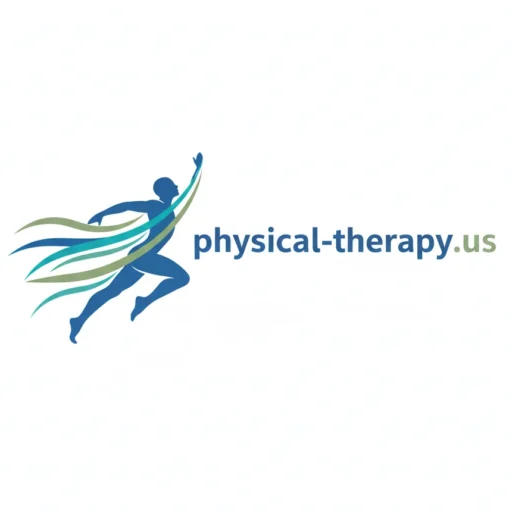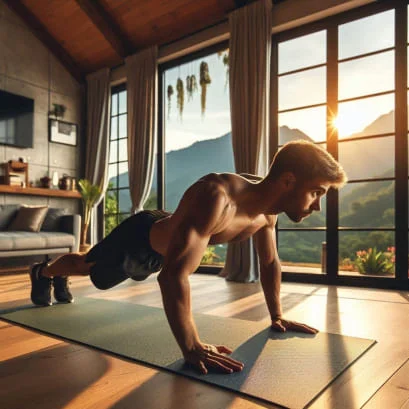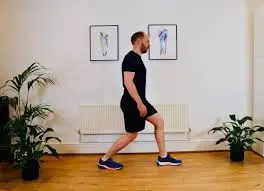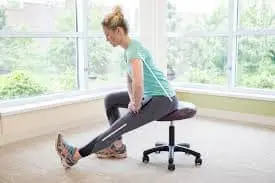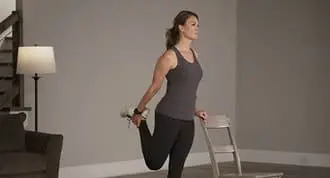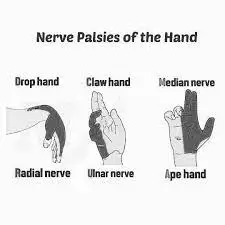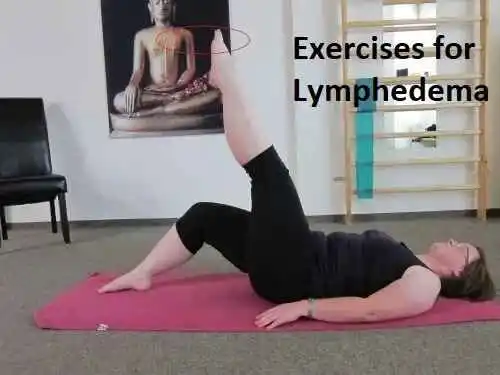16 Best Exercises for Gluteal Pain
Introduction:
The term “gluteal pain” describes any stiffness, hurting, or pain in the gluteal region, which includes the buttocks’ muscles, tendons, and tissues. This region is essential for supporting the hips and lower back, promoting mobility, and preserving posture.
Gluteal pain has too many causes and is usually managed with rest, medicine, and physical therapy exercises. Muscle abuse, minor sprains, infections, or incidents are the main causes of gluteal pain.
Mobility, everyday activities, and general quality of life may all be adversely affected by gluteal pain, which can be a chronic and annoying problem. Piriformis syndrome, sciatic nerve inflammation, muscle strain, and bad posture are some possible reasons. Fortunately, specific Exercises for Gluteal pain can increase flexibility, strengthen muscles, and reduce pain.
Causes:
Numerous things, such as strained muscles, compressed nerves, and underlying medical disorders, might result in gluteal pain.
Sciatica
- Sciatica is caused by compression or irritation of the sciatic nerve, which travels from the lower back to the buttocks and down the leg.
- The glutes may experience intense, burning pain, which frequently travels down the leg.
- Herniated discs, spinal stenosis, and piriformis syndrome are common causes of sciatica.
Overuse or Strain in the Muscles
- Repetitive motions, hard lifting, and excessive physical activity can all strain the gluteal muscles, causing stiffness and soreness.
- Muscle soreness and tiredness may also result from rapid increases in exercise intensity or poor form during workouts.
Sacroiliac Joint Impairment
- The lower spine and pelvis are joined by the sacroiliac (SI) joint.
- Lower back and gluteal pain may result from inflammation or misalignment of this joint.
- Sitting for extended periods, pregnancy, or trauma can all cause SI joint dysfunction.
Sedentary lifestyles and postural problems
- Long periods of sitting and bad posture can weaken the gluteal muscles, which can lead to pain and tension.
- Long-term sitting can also cause pain by compressing nerves and lowering blood supply to the area.
- The sciatic nerve can be compressed by tight or swollen piriformis muscles, which are found deep in the buttocks.
- Leg numbness, tingling, and gluteal pain may result from this.
- This issue may be worsened by prolonged sitting, incorrect stretching, or muscular imbalances.
Hamstring Tendinopathy
- Buttock pain may result from inflammation or degeneration of the hamstring tendons, which attach close to the glutes.
- This is typical of athletes and those who run cycles or do other repetitive motions.
Hip Osteoarthritis
- Osteoarthritis-related hip joint degeneration might result in pain that travels to the glutes.
- Symptoms like stiffness and decreased movement are typical.
Ischial or Trochanteric Bursitis Bursitis
- The fluid-filled sacs called bursae act as cushions for the tendons and bones.
- Deep, severe gluteal pain can be caused by trochanteric or ischial bursitis or inflammation of the bursa in the hip or buttock region.
- Repetitive motions, extended sitting, or direct trauma are frequently the causes of this illness.
- Nerves that pass through the glutes may be compressed by a bulging or herniated disc in the lower spine.
- Legs and glutes may become weak, numb, and painful as a result.
Medical Conditions or Infections
- Less frequently, fibromyalgia, infections (like abscesses), or referred pain from diseases like endometriosis or pelvic dysfunction can all contribute to gluteal pain.
Signs and symptoms:
Depending on the underlying reason, gluteal pain may appear in a variety of ways. It can range from minor pain to severe pain that interferes with everyday activities and mobility.
Here are a few typical symptoms and signs:
Pain Features
- A dull, painful sensation that is frequently linked to bursitis or muscle strain.
- Sciatica and piriformis syndrome are two nerve-related disorders that frequently cause sharp or shooting pain.
- A burning feeling is a sign of nerve irritation, including compression of the sciatic nerve.
- The cause of deep buttock pain may be sacroiliac joint dysfunction, trigger points, or tight muscles.
Associated Signs and Reasons
- Hip and gluteal stiffness: Usually caused by osteoarthritis or tight muscles.
- Numbness or tingling: An indication of nerve involvement, as in piriformis syndrome or sciatica.
- Leg or hip weakness: This may result from gluteal muscle dysfunction or nerve compression.
- Tenderness or swelling: This may be caused by infections, bursitis, or muscular injuries.
Location of Pain
- Central gluteal pain: Frequently associated with piriformis syndrome or muscle strain.
- Radiating pain down the leg could point to nerve compression, sciatica, or a herniated disc.
- Hip joint problems or bursitis may be indicated by pain in the outer buttocks or close to the hip.
- Lower buttock and thigh pain: May be caused by ischial bursitis or hamstring tendinopathy.
Symptoms Associated with Movement
- Long-term sitting pain is common in disorders such as nerve compression, ischial bursitis, and piriformis syndrome.
- Walking or running pain: This could be caused by sacroiliac joint dysfunction, gluteal tendinopathy, or hip osteoarthritis.
- Stair climbing pain is frequently caused on by strained or weak gluteal muscles.
- Standing up from a seated posture can be difficult, which may be a sign of joint dysfunction or muscular weakness.
Increasing Symptoms
- Worsening pain at night: This may be a sign of nerve problems, bursitis, or inflammation.
- Increased pain following exercise: Often associated with tendinopathy or misuse of muscles.
- Pain that gets worse as you stand for a long time: may be connected to muscle strain or sacroiliac joint problems.
Benefits of exercise:
One of the best strategies to avoid and treat gluteal pain is to engage in regular exercise. Exercises that increase mobility, strength, and flexibility can help treat the underlying causes of pain and enhance general function.
The following are some main advantages of exercising to relieve gluteal pain:
Improves Gluteal Muscle Strength
- Hip instability, lower back pain, and bad posture can all be caused by weak glutes.
- Bridges, squats, and clamshells are examples of strengthening exercises that improve muscle support and lessen the strain on nearby areas.
Reduces Stiffness and Tension in the Muscles
- Stretching and foam rolling are two exercises that help loosen up tense muscles in the lower back, hips, and glutes.
- This increases the range of motion and lessens pain from strained muscles or extended sitting.
Increases Pelvic and Hip Stability
- The gluteal muscles are essential for maintaining pelvic and hip stability.
- Stronger glutes lessen the pressure on the legs and lower back by helping to maintain good alignment.
Avoids Pain and Injuries in the Future
- Gluteal strength and training increase resistance to injuries caused by sports, daily tasks, or extended sitting.
- Frequent exercise lowers the chance of muscular imbalances and recurrent pain.
Improves Flexibility and Range of Motion
- Stretching and mobility exercises help to prevent stiffness and increase movement effectiveness.
- More hip and lower back range of motion helps keep the gluteal muscles from being overworked.
Improves Blood Flow
- Blood flow to the muscles is increased by movement, which helps carry nutrients and oxygen that promote healing and lower inflammation.
- Additionally, better circulation eliminates pollutants and lessens pain.
Encourages Good Movement and Posture
- Chronic gluteal pain can be worsened by bad posture and movement patterns.
- Core and glute activation exercises improve body mechanics and help avoid pain and injuries in the future.
Improves Mobility and Overall Function
- Walking, standing, and sitting are all made more pleasant by having strong, flexible glutes that improve overall movement.
- It also lessens fatigue and improves sports performance.
Reduces Compression in Nerves
- Nerve irritation is a feature of conditions including sciatica and piriformis syndrome.
- Certain stretches, such as the figure-four and piriformis stretches, release pressure on the sciatic nerve, reducing numbness and pain.
Improves Mental Health
- The body’s natural painkillers, endorphins, are released during exercise and can elevate mood and lower stress levels.
- Anxiety and sorrow can result from chronic pain, although physical activity promotes mental wellness in general.
Exercises for Gluteal pain:
Here are a few effective exercises to strengthen and relieve gluteal pain.
Bridges
An efficient exercise for reducing and avoiding gluteal pain is the glute bridge. It improves stability and lessens muscle imbalances that cause pain by strengthening the core, lower back, and glute muscles.
- Place your feet level on the floor, hip-width apart, and bend your knees while lying on your back on a mat.
- As your hands face down, rest your arms at your sides.
- Slowly raise your hips off the floor by using your glutes and core.
- Lift until your body is in a straight line from your shoulders to your knees, pressing via your heels rather than your toes.
- At the highest point, squeeze your glutes and hold the position for a few seconds.
- Maintaining an engaged core, slowly lower your hips back down to the beginning position.
- Then relax.
- Repeat these exercises five to ten times.
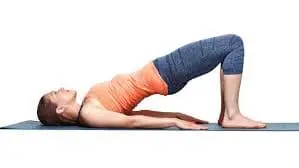
Seated hip abduction with resistance band
The gluteus medius and minimus, which are important for hip stability and lowering gluteal pain, are strengthened by the sitting hip abduction exercise with a resistance band. Those who are healing from injuries or who have weak glute muscles may particularly benefit from this workout.
- With your feet hip-width apart and flat on the floor, take a seat on a stable chair or bench.
- A resistance band should be positioned somewhat above your knees.
- Use your glutes and core.
- Keeping your feet in position, push your knees outward against the band.
- At the top of the exercise hold the position for a few seconds.
- Return your knees to the beginning position slowly.
- For optimal muscle activation, continue to move slowly and carefully.
- Then return to your neutral position.
- Then relax.
- Repeat these exercises five to ten times.
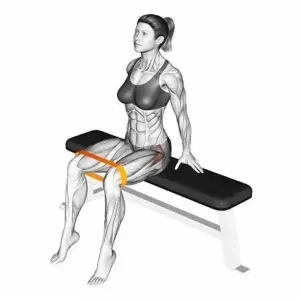
Prone leg raise
An excellent exercise for strengthening the lower back, hamstrings, and glutes, the prone leg raise also helps to improve hip stability and relaxed gluteal pain.
- Place your arms at your sides or beneath your forehead for support while lying face down on a mat with your legs straight.
- Maintain a neutral pelvis and space your feet hip-width apart.
- Use your glutes and core.
- Keep one leg straight and slowly raise it off the ground; do not bend the knee.
- Make sure your lower back is not arched when you raise your leg 6 to 12 inches.
- At the top, squeeze your glutes and hold for a few seconds.
- Return to the starting position by slowly lowering the leg.
- Then relax.
- Repeat these exercises five to ten times.
- Go over the opposite leg repeatedly.

Clamshells
By strengthening the gluteus medius and minimus, the clamshell exercise is a great way to stabilize the hips and lessen gluteal pain. People with sciatica, piriformis syndrome, weak glutes, or hip instability can particularly benefit from it.
- With your legs arranged on your side, bend your knees at a 45-degree angle.
- Your head should rest on your lower arm while your feet remain together.
- Get your glutes and core working.
- Lift your upper knee slowly while keeping your lower leg on the floor, keeping your feet together.
- Do not rotate your hips or pelvis; instead, spread your legs wide like a clamshell.
- Hold this position for a few seconds.
- After that, carefully lower your knee back down.
- Then return to your neutral position.
- Then relax.
- Repeat these exercises five to ten times.
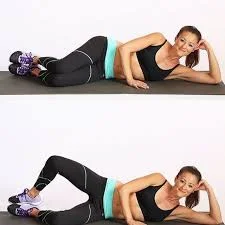
Knee to Chest
A straightforward yet efficient exercise for reducing hip tightness, lower back stress, and gluteal pain is the knee-to-chest stretch. It is especially helpful for people with tight hip muscles, sciatica, or piriformis disease.
- Stretch your legs out while lying flat on your back on a mat.
- Keep your arms at your sides in a comfortable position.
- Slowly bend one knee and raise it to your chest.
- If you are not very flexible, wrap both hands behind your thigh or around your knee.
- Pulling your leg gently toward your chest will cause your glutes and lower back to stretch comfortably.
- Hold this position for a few seconds.
- Lower your leg back down slowly.
- Then return to your neutral position.
- Then relax.
- Repeat these exercises five to ten times.
- Repeat with the other leg.
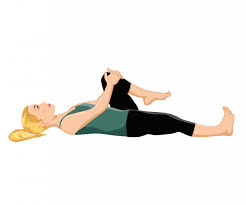
Side-lying hip abduction
An excellent exercise for strengthening the gluteus medius and minimus, which helps in hip stability and gluteal pain relief, is the side-lying hip abduction. Those who have weak glutes, sciatica, piriformis syndrome, or hip instability can particularly benefit from it.
- Maintain a straight and straight posture while lying on your side.
- For support, place your top hand on the floor and rest your head on your lower arm.
- Maintain your core engaged and your body aligned.
- Keep your top leg straight, and slowly raise it toward the ceiling.
- Do not lean back or rotate your hips.
- Raise until your glutes and outer hips begin to tense.
- Hold this position for a few seconds.
- Then slowly return to the starting position by lowering the leg.
- Then relax.
- Repeat these exercises five to ten times.
- Repeat with the opposite leg.

Glute bridge with band
A great exercise for strengthening the gluteus maximus, medius, and minimus, increasing hip stability, and easing gluteal pain is the glute bridge with a resistance band. Using a band increases glute activation, which improves the exercise’s ability to reduce pain.
- Your feet should be hip-width apart and flat on the floor.
- Afterward, bend your both knees.
- A resistance band should be positioned somewhat above your knees.
- With your hands pointing down, put your arms by your sides.
- To keep the strain, press your knees slightly outward against the band.
- To make your body into a straight line from shoulders to knees, push through your heels and raise your hips off the floor.
- For a few seconds, squeeze your glutes and hold the top position.
- Lower your hips back down slowly, but do not completely rest.
- Then return to your neutral position.
- Then relax.
- Repeat these exercises five to ten times.
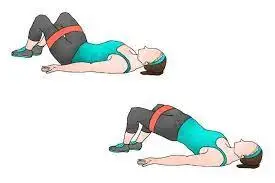
Hamstring stretch
An excellent exercise for lowering gluteal pain, increasing flexibility, and releasing tension in the legs and lower back is the hamstring stretch.
- Place both legs out in front of you while lying flat on your back.
- Maintain a neutral spine and relaxed shoulders.
- Wrap a resistance band, towel, or strap around your right foot’s arch.
- Raise your right leg while keeping your left leg flat on the ground.
- Lift your right leg gently toward you with the strap or towel until your glutes and hamstrings start to stretch.
- Hold this position for a few seconds.
- Slowly lower your leg and switch sides.
- Then return to your neutral position.
- Then relax.
- Repeat these exercises five to ten times.
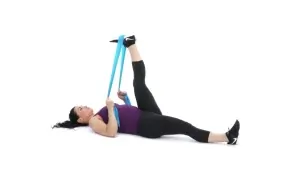
Glute foam roll
A great self-myofascial release (SMR) method for relieving gluteal pain, increasing blood flow, and reducing muscular tension is foam rolling the glutes.
- Put a foam roller under your glutes and sit on it.
- Maintain a bent knee position and flat feet on the ground.
- Put your hands behind your back for balance.
- In the figure-four position, cross your opposite ankle over your knee to shift your weight onto one glute.
- Roll back and forth slowly, focusing on any sore or tight areas of the glute muscles.
- To relieve stress, keep the position for a few seconds if you detect a sore spot.
- Then return to your neutral position.
- Then relax.
- Repeat these exercises five to ten times.
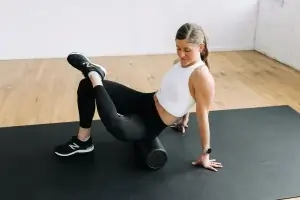
Seated figure-four stretch
A great stretch for reducing gluteal pain is the Seated Figure-Four Stretch. It helps in releasing the piriformis muscle, which can become tight and affect the sciatic nerve, resulting in lower back and gluteal pain.
- Your feet should be flat on the floor when you sit on a stable chair or bench.
- Keep your core active and your back straight.
- Make a figure-four with your right ankle crossed over your left thigh.
- To increase the length of the stretch, gently press your right knee downward.
- Lean forward from your hips a little if it is comfortable to extend the stretch.
- Hold this position for a few seconds.
- Then return to your neutral position.
- Then relax.
- Repeat these exercises five to ten times.
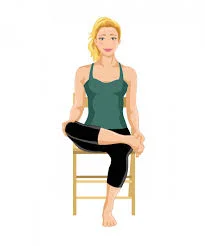
Seated twist
An excellent technique for reducing hip and lower back strain, increasing spinal mobility, and relieving gluteal pain is the Seated Twist Stretch. It relieves tension in the lower back, piriformis, and glutes, which can cause stiffness and pain.
- With your legs out straight, take a seat on the floor.
- Keep your shoulders loose and your back straight.
- Cross your right foot over your left leg and rest it flat on the floor while bending your right knee.
- Support yourself with your right hand behind you.
- At the outside of your right knee, extend your left elbow.
- Turn your body slightly to the right while looking over your right shoulder.
- Hold this position for a few seconds.
- Then return to your neutral position.
- Then relax.
- Repeat these exercises five to ten times.
- Repeat on the other leg.
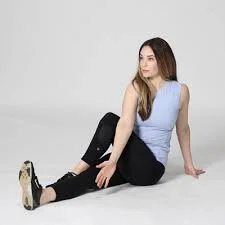
Child’s Pose with Side Stretch
A mild yet powerful stretch that helps release tight hips, increase lower back flexibility, and relieve gluteal pain is the Child’s Pose with Side Stretch.
- With your knees stretched apart and your big toes touching, begin by kneeling.
- With your arms out on the floor, sit back on your heels.
- While maintaining your hips down, walk your hands to the right.
- Your left glute, hip, and side body should all feel stretched.
- Hold this position for a few seconds.
- Walk your hands back to the center slowly.
- Stretch the right side body and glutes, then repeat on the left side.
- Then return to your neutral position.
- Then relax.
- Repeat these exercises five to ten times.

Bird dog
In order to increase stability and alleviate gluteal pain, the Bird Dog exercise is an excellent way to strengthen your lower back, core, and glutes.
- Start on all fours, quadrupedally, with your knees beneath your hips and your hands directly beneath your shoulders.
- At the same time, extend your left leg straight back and your right arm forward.
- Avoid excessive lower back arching and maintain a level hip position.
- At the highest point, hold for a few seconds while using your core and glutes.
- Go back to the starting position slowly.
- Then return to your neutral position.
- Then relax.
- Repeat these exercises five to ten times.
- Repeat with the left arm and right leg on the other side.
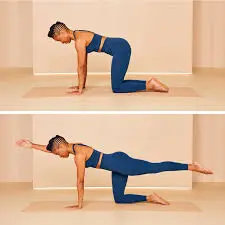
Piriformis Stretch
One good stretch for gluteal pain relief is the Supine Piriformis Stretch. It helps in the release of tension in the piriformis muscle, which can tighten and worsen the sciatic nerve, causing leg and gluteal pain.
- On a mat, lie flat on your back with your feet flat on the ground and your knees bent.
- Make a figure-four with your right ankle crossed over your left thigh.
- Grab the area behind your left thigh by reaching through the gap of your legs.
- You should feel a stretch in your right hip and glute as you slowly draw your left thigh toward your chest.
- Relax your shoulders and keep your back flat on the ground.
- Hold this position for a few seconds.
- Then return to your neutral position.
- Then relax.
- Repeat these exercises five to ten times.
- Repeat with the other leg.
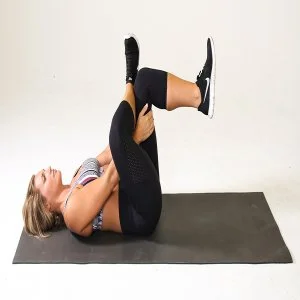
Standing figure-four stretch
One excellent technique to relieve gluteal pain is to perform the Standing Figure-Four Stretch, which releases tension in the hips, lower back, and glutes.
- With your feet hip-width apart, take a straight position.
- Maintain a straight posture and contract your core.
- Your left leg should take on more weight.
- Make a figure-four with your right foot up and your right ankle crossed over your left leg.
- To get into a seated position, slowly bend your standing knee while maintaining a straight back.
- To increase the stretch in your glutes and outer hip, press your right knee down.
- Hold this position for a few seconds.
- Then return to your neutral position.
- Then relax.
- Repeat these exercises five to ten times.
- Use the other leg to perform the exercises again.
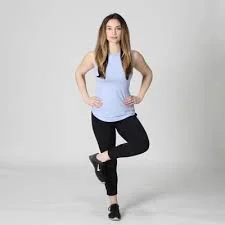
Pigeon Pose
A deep stretch that relieves stress in the hips, lower back, and glutes is the Pigeon Pose.
- Start from a downward dog position or on all fours in a tabletop position.
- Your right knee should be brought forward and positioned behind your right wrist.
- Keep the toes of your left leg pointed back as you extend it straight behind you.
- While maintaining an upright body, straighten your hips.
- Place your upper body on your forehead or forearms and lower it over your right leg if it feels comfortable.
- Hold this position for a few seconds.
- Then return to your neutral position.
- Then relax.
- Repeat these exercises five to ten times.
- Repeat the same on the other side.
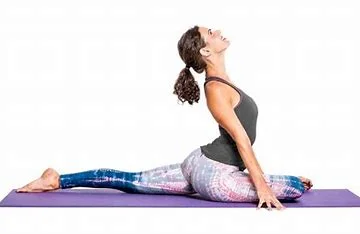
When exercising, what precautions should be taken?
It’s important to take the right precautions when exercising to reduce gluteal pain in order to avoid making the condition worse or getting hurt again.
Here are important safety measures to follow:
Properly Warm Up
- Always begin with a 5- to 10-minute warm-up that includes dynamic movements, light stretching, or walking.
- A good warm-up lowers the risk of strain by increasing blood flow and getting the muscles ready for exercise.
Select Low-Impact Activities
- Stay away from sudden direction changes or high-impact activities like jumping since these may worsen the pain.
- To safely increase your strength, choose regulated, mild activities like sitting stretches, clamshells, and glute bridges.
Keep Yourself Hydrated and Take Breaks
- To avoid fatigue and cramping in your muscles, drink plenty of water.
- Avoid overworking painful muscles and take rests as necessary.
Begin slowly and make progress over time.
- To figure out your comfort level, start with low-intensity workouts and limited ranges of motion.
- As your pain slows down, progressively increase the resistance, repetitions, and intensity.
- If you experience sudden pain pay attention to your body and stop.
Don’t Overstretch
- Stretching relieves tightness, but stretching too much may worsen the condition.
- For 20 to 30 seconds, hold each stretch gently without pushing or jumping over what is comfortable.
Keep Your Posture and Form Correct
- Use proper form when performing workouts to prevent unnecessary strain.
- When performing out, use your glutes and core to provide yourself stability.
- Don’t place too much weight on one side or overarch your lower back.
Adjust or Change Exercises as Necessary
- Change a workout or find a better alternative if it hurts.
- Try a pelvic tilt exercise instead, for instance, if glute bridges hurt.
- Stay away from exercises that require a lot of bending, twisting, or extended gluteal pressure.
Make Use of Supportive Equipment
- For extra cushioning when performing floor exercises, use a yoga mat.
- Use a foam roller if needed to gently release tense muscles, but do not roll directly over sore spots.
- Muscles can be strengthened with resistance bands without putting unnecessary stress on them.
After working out, calm down.
- To relax your muscles, stretch gently and take deep breaths after your workout.
- If necessary, use heat therapy or ice to relieve pain.
If necessary, consider professional advice.
- See a physician or physical therapist for individualized advice if the pain continues or gets worse.
- Before beginning an exercise plan, get professional guidance if you already have a medical condition (such as sciatica, arthritis, or a herniated disc).
When should you quit working out?
Even while exercising can reduce gluteal pain, there are situations in which it could get worse. If you experience any of the following, stop working out:
Acute or Severe Pain
- Stop right away if you have a sudden, sharp, or stabbing pain in your lower back, hips, or glutes.
- This can be a sign of a joint problem, nerve irritation, or muscle rupture.
Tingling, Weakness, or Numbness
- Stop doing out if your legs, feet, or glutes start to feel numb, tingly, or weak.
- These may indicate piriformis syndrome, a ruptured disc, or compression of the sciatic nerve.
Pain That Gets Worse When You Work Out
- While little pain is common, your body might not be prepared for that action if the pain gets worse during or after exercise.
- Continued use may exacerbate an underlying injury or irritation.
Pain That Gets in the Way of Everyday Tasks
- You might need to take a break from activity and give yourself time to recover if it makes it uncomfortable to sit, stand, walk, or sleep.
Reduced Range of Motion
- You might be doing more harm than good if you have trouble moving your hip, knee, or lower back comfortably.
- Pain and stiffness together may be signs of muscle injury or joint dysfunction.
Redness, bruising, or swelling
- A muscular strain, inflammation, or bursitis may be the cause of any swelling, redness, or warmth in the gluteal region.
- In this situation, exercising could make the injury worse.
Extreme exhaustion or lightheadedness
- Stop right away and take a break if you have lightheadedness, dizziness, or excessive fatigue.
- These symptoms may be caused by dehydration, low blood sugar, or excessive effort.
After multiple sessions, there was no improvement.
- Your present strategy might not be working if you’ve been exercising for a few weeks and your symptoms haven’t improved or gotten worse.
- Think about changing the exercises or consulting a physician or physical therapist for advice.
Which exercises should you avoid if you have gluteal pain?
Some workouts may worsen gluteal pain by overtaxing the muscles, joints, or nerves. The following exercises should be avoided or modified if you have gluteal pain:
- Deep Squats
Contributes to pain by placing undue strain on the hips, lower back, and glutes.
- The Leg Press Machine
High resistance and a sitting position can overwork the lower back and glutes.
- High-impact exercises (sprinting and jumping)
Exercises like sprints, jump squats, and box jumps may increase nerve irritation and muscular tension.
- Climbing stairs (if it makes your pain worse)
Conditions like sciatica or gluteal tendinopathy might get worse with repeated stair climbing.
- Lunges, particularly weighted or deep lunges
May worsen muscular imbalances by putting force on the hip flexors and glutes.
- Extended Sitting Activities (such as Rowing Machines)
Long-term sitting, particularly on hard surfaces, may worsen ischial bursitis and piriformis syndrome.
- Excessive twists of the core (similar to Russian twists)
Twisting motions could worsen pain by putting tension on the glutes and lower back.
- Deadlifts (particularly those that are heavy or performed incorrectly)
Deadlifts can put excessive stress on the glutes and lower back if done improperly.
- Heavy Lifting Without the Right Form
Additional strain may result from heavy lifting if the glutes and core are not properly engaged.
- Examples of Exercises That Compress the Sciatic Nerve:
Romanian deadlifts
Straight-leg raises
Hamstring stretches with locked knees
The sciatic nerve may be compressed or stretched by these motions, causing nerve pain.
What steps can I take to help prevent gluteal pain?
Gluteal pain can be avoided by maintaining flexible, strong muscles, adopting a healthy posture, and changing one’s lifestyle. The following are essential actions to prevent gluteal pain:
Make Your Gluteal Muscles Stronger
- Pain and muscular imbalances can result from weak glutes.
- To maintain strong and supportive muscles, use strengthening exercises such as hip thrusts, clamshells, and glute bridges.
Stay away from extended sitting
- Over time, prolonged sitting weakens and tightens the glutes.
- Every thirty to sixty minutes, get up stretch, or take an instant walk.
Use Body Mechanics Correctly
- Use your legs and core when lifting something, not simply your glutes or lower back.
- Squat down and maintain a neutral spine instead of bending at the waist.
Stretching to Increase Flexibility
- Pain may be exacerbated by tight hamstrings, hip flexors, and glutes.
- To preserve flexibility, perform figure four, hamstring, and piriformis stretches every day.
Keep a Healthy Weight
- The gluteal muscles and joints are subjected to greater strain when one is overweight.
- Regular exercise and a healthy diet can help avoid putting further strain on these areas.
Keep Your Posture Correct
- Standing or sitting with bad posture can put tension on the lower back and glutes.
- Avoid bending over, maintain a straight back, and use your core.
- If you spend a lot of time sitting, use an ergonomic chair.
Keep Moving with Low-Impact Activities
- Frequent exercise keeps muscles from becoming weak and rigid.
- Walking, swimming, and cycling are exercises that keep the glutes active and are easy on them.
Wear footwear that provides support.
- Poorly supportive shoes can cause muscular imbalances and change your gait.
- Put on supportive, comfortable footwear that offers enough arch and heel support.
Prevent Overtraining and Unexpected Changes in Intensity
- Increase the intensity of your workouts gradually to avoid strain or injury.
- Before working out, always warm up, and thereafter, cool down.
Control Tension in Your Muscles and Stress
- Gluteal pain might result from muscle tightness caused by prolonged stress.
- Muscle relaxation techniques include massage therapy, yoga, and deep breathing.
Get Pain Treatment as Soon as Possible
- Take care of any small pain as soon as possible by resting, applying cold or heat therapy, or gently stretching.
- To avoid things getting worse, see a doctor or physical therapist if the pain doesn’t go away.
Summary:
Gluteal pain can be caused by a variety of medical disorders, including sciatica and piriformis syndrome, prolonged sitting, nerve compression, and muscular stress. Stretching and strengthening exercises can help lessen pain, improve range of motion, and prevent it from returning.
It can be anything from minor pain to severe pain that gets in the way of everyday tasks. Depending on the underlying reason, the gluteal pain may be localized or extend to the legs, hips, or lower back. Depending on the patient’s condition, a physical therapist might create a rehabilitation
a program that includes mobility, strengthening, and stretching exercises.
See a healthcare provider if your gluteal pain lasts during exercise or gets worse over time. Chronic pain can be a sign of a problem that needs to be treated.
FAQ:
Which workouts are most effective for reducing gluteal pain?
The most effective gluteal pain exercises include mobility, strength, and mild stretching. Among the more successful ones are:
Glute Bridges
Clamshells
Piriformis Stretch
Figure-Four Stretch
Seated or Standing Hip Abductions
How frequently should I perform exercises for gluteal pain?
Every day, perform stretches that you can hold for 20 to 30 seconds.
To prevent overtaxing the muscles, perform strengthening exercises three to four times a week.
Mobility exercises: When necessary, especially before and following physical activity.
Can I work out if I have gluteal pain?
Yes, but only if the pain doesn’t get worse after the exercises. Avoid uncomfortable activities and keep to low-impact motions. Stop and get expert help if you have sharp, shooting, or persistent pain.
How long does it take for exercise to relieve gluteal pain?
With regular stretching and strengthening, minor soreness should go away in a few days to two weeks.
Depending on its degree and origin, chronic pain can last anywhere from a few weeks to many months.
Take medical care if the pain lasts longer than six weeks.
If I’m experiencing gluteal soreness, which workouts should I avoid?
Deep squats
Heavy deadlifts
Jumping exercises (box jumps, jump squats)
Sprinting or running on hard surfaces
Prolonged stair climbing
Do weak muscles cause gluteal pain?
Incorrect posture, hip instability, and compensatory movement patterns that overwork other muscles are all signs that weak gluteal muscles cause pain. Preventing and alleviating pain is facilitated by strengthening the glutes.
When I have gluteal pain, should I apply ice or heat?
Particularly after exercise, ice therapy (15–20 minutes) lowers edema and inflammation.
Before stretching, heat therapy (15–20 minutes) helps improve blood flow and relax tense muscles.
Choose the approach that is most comfortable for your health.
Can prolonged sitting lead to gluteal pain?
Indeed! Long periods of sitting can result in pain from nerve compression, tight muscles, and decreased blood flow. Try:
Taking 30- to 60-minute breaks.
Use a seat cushion or ergonomic chair.
Throughout the day, perform standing workouts and seated glute stretches.
Could sciatica be the cause of gluteal pain?
Indeed, sciatica frequently results in numbness, tingling, or pain radiating down the leg because it compresses the sciatic nerve. In order to reduce pressure, concentrate on piriformis exercises, nerve flossing, and core strengthening if you suspect sciatica.
When should I consult a physician about my gluteal pain?
If the pain is serious or ongoing (lasting more than six weeks), see a physician or physical therapist.
You feel weakness, tingling, or numbness in the affected leg.
Movement worsens the pain, or rest and exercise have little effect.
You find it difficult to sit, stand, or walk comfortably.
References:
- N. P.-. Physiotherapist (2024, February 11). Origin, Insertion, Innervation, and Exercise of the Gluteus Muscle. Mobile Clinic for Physiotherapy. Details and exercises for the gluteal muscles can be found at https://mobilephysiotherapyclinic.in/
- Ladva, V. June 17, 2023. The causes, symptoms, diagnosis, and treatment of gluteal discomfort. Samarpan Clinic for Physiotherapy. Gluteal muscle pain: https://samarpanphysioclinic.com/
- Nunez, K. February 10, 2023. Seven simple methods for stretching tense glutes. How-to-stretch-glutes: Healthline. https://www.healthline.com/health/exercise-fitness
- Dumain, T. June 2, 2023. Try these seven exercises to ease buttock pain. https://creakyjoints.org/diet-exercise/buttock-pain-exercises/ CreakyJoints
- Editorial Contributor at WebMD. January 26, 2025. The best gluteal tendinopathy workouts. WebMD. https://www.webmd.com/a-to-z-guides/gluteal-tendinopathy-best-exercises
- American Knee Pain Centers. (undated). Crucial exercises for gluteal medius discomfort. Exercises for gluteus-medius pain https://www.kneepaincentersofamerica.com/blog/
- Chertoff, J. (April 24, 2020). Eight exercises to prevent and relax tense glutes. Healthline. Tight-glutes https://www.healthline.com/health
- Heffernan/Stone/GettyImages, M., and Bailey, A. (2020, March 24). exercises to ease gluteal maximus pain. Livestrong.com. Exercises for gluteal-maximal pain: https://www.livestrong.com/article/367329-exercises/#google_vignette
- Website, N. (September 26, 2023a). Glutes workout video. Nhs.uk. Body-blast-bums: https://www.nhs.uk/live-well/exercise/strength-and-resistance
- Image 9, Cpt, L. B. January 10, 2024. The Top 8 Foam Roller Exercises (Foam Roller Stretches for Recovery Day). Eat, Move, and Love. This article describes the top foam roller exercises.
- Image 12, Song, D. June 21, 2023. Rehab hero: child’s posture side stretch. Hero for Rehab. The child’s pose-side stretch exercise can be found at https://www.rehabhero.ca.
